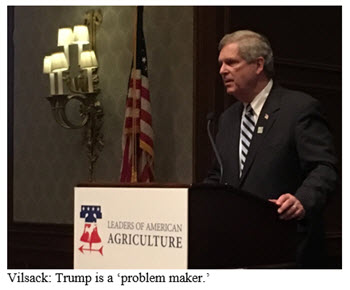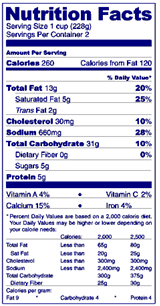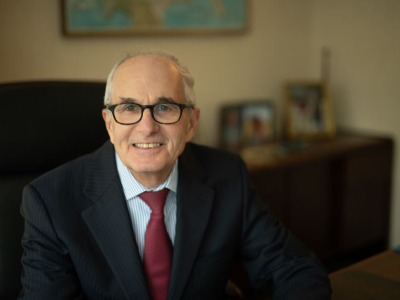The March edition of the National Geographic Magazine, in its cover story entitled “The War on Science” notes that “there’s no evidence that GMO’s are harmful to human health.” A recent Pew poll found that 90% of all scientists believe GMO’s are safe but only 37% of the public. In short, the public is skeptical and is seeking more information about foods made with genetic engineering. We live in an era of transparency, open data and the world-wide web. It is difficult to deny consumers the right to know what is in their food. And given the safety of genetic engineering there is no reason to block that information.
The question on the table is how to do this in a nationally-uniform, unbiased manner? To allow each of fifty states to have its own labeling scheme would be confusing, very expensive bad public policy and, in my opinion, unconstitutional. It would be as crazy as having fifty different Dietary Guidelines of fifty different Nutrition Facts panels on the foods we buy.

Secretary Tom Vilsack has a better idea: a smartphone application that can scan a bar code on the food and tell the consumer what is in the product. He took his idea to Congress last month. His idea is a very modern and clever solution to the desire for more information about the foods we consume.
There is only so much room on the food label. So, Secretary Vilsack is suggesting a symbol on the food label that connects to a database that can tell those consumers who want such information whether there is an ingredient in the food produced with genetic engineering. According to a recent edition of the Economist, “about half of the adult population owns a smartphone; by 2020, 80% will. Smartphones have also penetrated every aspect of daily life.” For those without smartphones there could be in-store computers or scanners.
Dr. Cathy Enright, VP for Agriculture at the Biotechnology Industry Organization (BIO) posted a blog last month that said:
“I also support a right-to-know. In 21st century America, consumers are increasingly asking questions about how their food is grown and made. We all need to be working together to provide that information, in a way that doesn’t misinform consumers. Have you seen USDA Secretary Vilsack ‘s idea….using a bar code or other code on a food package or sticker?”
Last year, Cardinal Peter Turkson speaking on behalf of the Vatican said we must use biotechnology to feed the world’s expanding population but also supported the idea of transparency to provide information to consumers who desire such information. The Vatican seems to be in agreement with the Secretary and those who believe in the both the safety of genetic engineering, the moral imperative of using science to feed the hungry but also the consumers’ right to know.
USDA and HHS will issue a new edition of the Dietary Guidelines for Americans later this year. The Dietary Guidelines Advisory Committee and the FDA are seeking to put more information on the actual food label. It is time to use technology to expand the physical size of the label. 
Every industry seems to be using technology to the maximum possible extent. The food industry should follow suit. There are questions that would still have to be resolved with any app: who would maintain the data base? What would be the definition of genetic modification and would there be some threshold that triggers the GE designation? What happens with foods that used a GE ingredient where it was then processed out of the product and there is no trace in the final food?
These are all challenging questions that would have to be resolved. But this much is clear, there must be federal preemption of state labeling schemes and a uniform national system established. To date, the labeling campaign has been pushed as an attack on genetic engineering as a part of the larger war on science. Information should be provided, not as a scare tactic and warning, but just as factual information for those who care.
Perhaps there is a better idea than the Vilsack App, but this idea sure deserves serious attention. On March 5th, at the House Agriculture Appropriations Subcommittee hearing to review the FDA budget, Dr. Hamburg reiterated that FDA does not see mandatory labeling as appropriate if there’s not a significant change to the product. If the process changes the nature of the product, then it would have to be labeled. She also said FDA supports individual companies that want to voluntarily label products and plans to issue a guidance to guide them in the near future. Dr. Hamburg should include the Vilsapp as a way of providing consumer information and include it in the guidance that FDA issues.
The Wall Street Journal recently published a guide to some of the terms being used on supermarket egg cartons. They include Organic, Cage-Free, Free-Range, All Natural, Pasture Raised, and Vegetarian Fed and Omega-3. The Vilsapp could help the confused consumer better understand these terms as well.
In short, the Vilsapp is a creative idea that could provide the transparency deemed important by consumers and also preempt the need for state legislation. The need for state preemption is paramount and was emphasized by all of the witnesses at the House Agriculture Hearing on March 24th.
Dr. Nina Fedoroff, the Senior Science Advisor at OFW Law, concluded her testimony as follows: “We will need to produce more crops per drop of water and square meter of land” in order to feed 9 to 10 billion of people. Genetic modification is not a magic bullet but is safe and an important part of the arsenal need to defeat food insecurity.
A patch quilt of different state labeling schemes would be a barrier to global food security. Transparency and full disclosure is reasonable but it must be done with a national system that is based on sound science and provides objective information.
Mr. Collin Peterson, the Ranking Member, summed it up best: “When it comes to labeling we need to be able to find a smart way to balance the consumer demand with what we know about the safety of the foods that our farmers produce.” Sounds like a Vilsapp.
Marshall Matz, formerly Counsel to the Senate Select Committee on Nutrition and the Senate Committee on Agriculture, specializes in agriculture and nutrition at OFW Law. mmatz@ofwlaw.com
For more news go to: www.Agri-Pulse.com

